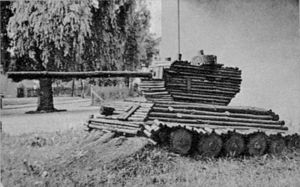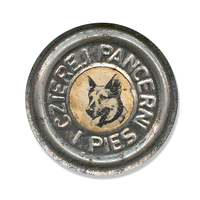
Czterej pancerni i pies
Encyclopedia

Poland
Poland , officially the Republic of Poland , is a country in Central Europe bordered by Germany to the west; the Czech Republic and Slovakia to the south; Ukraine, Belarus and Lithuania to the east; and the Baltic Sea and Kaliningrad Oblast, a Russian exclave, to the north...
black and white TV series based on the book
Book
A book is a set or collection of written, printed, illustrated, or blank sheets, made of hot lava, paper, parchment, or other materials, usually fastened together to hinge at one side. A single sheet within a book is called a leaf or leaflet, and each side of a leaf is called a page...
by Janusz Przymanowski. Made between 1966 and 1970, the series is composed of 21 episodes of 55 minutes each, divided into three seasons. It is set in 1944 and 1945, during World War Two
World War II
World War II, or the Second World War , was a global conflict lasting from 1939 to 1945, involving most of the world's nations—including all of the great powers—eventually forming two opposing military alliances: the Allies and the Axis...
, and follows the adventures of a tank crew and their T-34
T-34
The T-34 was a Soviet medium tank produced from 1940 to 1958. Although its armour and armament were surpassed by later tanks of the era, it has been often credited as the most effective, efficient and influential design of World War II...
tank in the 1st Polish Army
First Polish Army (1944-1945)
The Polish First Army was a Polish Army unit formed in the Soviet Union in 1944, from the previously existing Polish I Corps as part of the People's Army of Poland . The First Army fought westward, subordinated to the Soviet 1st Belorussian Front, during the offensive against Germany that led to...
. Although both the book and the TV series contain elements of pro-Soviet propaganda, they have achieved and retain a cult series status in Poland, Soviet Union and other eastern block countries.
The T-34 tank Rudy (Redhead
Redhead
Redhead may refer to:* A person with red hair* Redhead , an album by Bleu* Redhead , a North American duck, Aythya americana...
) with the identifying number '102', a German Shepherd Dog
German Shepherd Dog
The German Shepherd Dog , also known as an Alsatian or just the German Shepherd, is a breed of large-sized dog that originated in Germany. The German Shepherd is a relatively new breed of dog, with its origin dating to 1899. As part of the Herding Group, the German Shepherd is a working dog...
from Siberia
Siberia
Siberia is an extensive region constituting almost all of Northern Asia. Comprising the central and eastern portion of the Russian Federation, it was part of the Soviet Union from its beginning, as its predecessor states, the Tsardom of Russia and the Russian Empire, conquered it during the 16th...
Szarik (a little ball
Ball (mathematics)
In mathematics, a ball is the space inside a sphere. It may be a closed ball or an open ball ....
in Russian, in Polish the word is similar to Szary meaning gray and szalik meaning scarf
Scarf
A scarf is a piece of fabric worn around the neck, or near the head or around the waist for warmth, cleanliness, fashion or for religious reasons. They can come in a variety of different colours.-History:...
) and to a lesser extent the crew Jan Kos, Gustaw Jeleń, Grigorij Saakaszwili, Tomasz Czereśniak, and their commander and mentor Olgierd Jarosz, as well as other heroes of the series, have become icons in Polish popular culture
Popular culture
Popular culture is the totality of ideas, perspectives, attitudes, memes, images and other phenomena that are deemed preferred per an informal consensus within the mainstream of a given culture, especially Western culture of the early to mid 20th century and the emerging global mainstream of the...
.
The popularity of the series came from it being the first postwar series to depict the era of World War II in a somewhat lighter vein. As the tragic events of the war receded, the Polish public became tired of the mandatory dark, tragic tone of previous television series and films dealing with wartime events. A similar change in attitudes occurred elsewhere in the world at the time. At the same time the series was definitely not a comedy and contained many sad moments and intense battle scenes, while some of the main characters were wounded or killed.
All main heroes were in a way extraordinary. The youngest, Janek Kos, was a marksman
Marksman
A marksman is a person who is skilled in precision, or a sharpshooter shooting, using projectile weapons, such as with a rifle but most commonly with a sniper rifle, to shoot at long range targets...
, and owner of a well-trained and clever dog Szarik. The loader Gustlik, from Silesia
Silesia
Silesia is a historical region of Central Europe located mostly in Poland, with smaller parts also in the Czech Republic, and Germany.Silesia is rich in mineral and natural resources, and includes several important industrial areas. Silesia's largest city and historical capital is Wrocław...
, was very strong, while Grigorij (Russian name Grigoriy) was a skilled driver. Grigorij himself was a Georgian
Georgians
The Georgians are an ethnic group that have originated in Georgia, where they constitute a majority of the population. Large Georgian communities are also present throughout Russia, European Union, United States, and South America....
, representing numerous soldiers of the Soviet Army assigned to Polish tank units lacking specialists. The first commander Olgierd Jarosz was a meteorologist and could forecast the weather (in the book he was Russian Wasyl (Vasiliy) Semenov). Tomek, the last member of the crew (appearing later), was joyful and played the accordion
Accordion
The accordion is a box-shaped musical instrument of the bellows-driven free-reed aerophone family, sometimes referred to as a squeezebox. A person who plays the accordion is called an accordionist....
.
The upbeat view of the war shown in the series was popular, but in many ways problematic. From the standpoint of military realism, the series is in fact almost grotesque, as its heroes have a very relaxed concept of military discipline, frequently fight their own "private" battles in defiance of orders, and effortlessly defeat German soldiers, who are depicted as faceless military incompetents (see Stormtrooper effect
Stormtrooper effect
The Principle of Evil Marksmanship states that enemy marksmen in action films are often very bad shots and almost never harm the main characters. They are generally only capable of hitting a target if the target is either of no value to the plot or if their death will advance said plot...
). The series is also loaded with a dose of pro-Soviet and pro-Russian propaganda. An emphasis is put on friendship between front-line Polish and Soviet soldiers, but little or no mention of the problems in general Polish-Soviet relations of that era (though they were often suggested in background).
Despite its shortcomings, the series retained its huge popularity and was rerun yearly in Poland until 1989. After 1989 the series is still being sporadically shown in Poland. It was also shown in other countries of the Soviet bloc.
In 2000s the series was released on DVD.
The crew
- Olgierd Jarosz, "Olgierd" - first commander. Played by Roman WilhelmiRoman WilhelmiRoman Wilhelmi was a Polish theatre and film actor, notable for his roles in two of the most popular Polish television series of the 1980s....
. - Gustaw Jeleń, "Gustlik" - loader. Played by Franciszek PieczkaFranciszek PieczkaFranciszek Pieczka is a Polish film and stage actor. A graduate of the Theatrical Academy in Warsaw, he first made his debut in the theatre in Jelenia Góra...
. - Jan Kos, "Janek" - gunner/radio operator, later the second commander. Played by Janusz GajosJanusz GajosJanusz Gajos is a Polish actor.He graduated in 1965 from the National Film School in Łódź as one of its best students despite having been rejected during entrance exams for three times. He debuted while he was still in film school in children's film Panienka z okienka in 1964...
. - Grigorij Saakaszwili, "Grześ" - driver. Native GeorgianGeorgiansThe Georgians are an ethnic group that have originated in Georgia, where they constitute a majority of the population. Large Georgian communities are also present throughout Russia, European Union, United States, and South America....
. Played by Włodzimierz Press. - Tomasz Czereśniak, "Tomuś, Tomek" - second gunner/radio operator. Played by Wiesław Gołas.
Other
- Marusia "Ogoniok" - Russian nurse, played by Pola RaksaPola RaksaPola Raksa is a Polish movie star, singer, model was especially popular in Poland and abroad in the 1960s and 1970s.The daughter of Edward Raksa, Pola was born at Szeroka street in Lida on April 14, 1941...
. - Lidia Wiśniewska, "Lidka" - radio operator, played by Małgorzata Niemirska.
- Franek Wichura - truck driver, played by Witold PyrkoszWitold PyrkoszWitold Pyrkosz - Polish actor. He is best known as Lucjan Mostowiak in a very popular Polish serial "M jak miłość", as Pyzdra in "Janosik", as Wichura in "Czterej pancerni i pies" and as Balcerek in "Alternatywy 4"....
. - The Colonel - played by Tadeusz Kalinowski.
- At least two real tanks were used in this movie. One of them was used for taking scenes inside of a tank with cameras placed in hull, now displayed in museum of armoured weapon in Center of Training of Land Forces in PoznańPoznanPoznań is a city on the Warta river in west-central Poland, with a population of 556,022 in June 2009. It is among the oldest cities in Poland, and was one of the most important centres in the early Polish state, whose first rulers were buried at Poznań's cathedral. It is sometimes claimed to be...
. Although there are references to T-34 armed with 76 mm gun, the tank in a movie is T-34/85.
List of episodes


- Załoga (Crew)
- Radość i gorycz (Happiness and Bitterness)
- Gdzie my – tam granica (Where We Are, There's the Border)
- Psi pazur (Dog's claw)
- Rudy, miód i krzyże (“Ginger”, Honey and Crosses)
- Most (Bridge)
- Rozstajne drogi (Crossroads [We Are Separating])
- Brzeg morza (Seashore)
Season II, 1969
- Zamiana (Exchange)
- Kwadrans po nieparzystej (A Quarter Past an Odd Hour)
- Wojenny siew (Wartime SowSowSow may refer to:* Sowing seed* Female animals: badger, bear, pig family* Shape in which metal is cast* Type of siege engine* River Sow, England* "Sow", a poem by Sylvia Plath* Sow , the band/spoken word project comprising Anna Wildsmith-People:...
) - Fort Olgierd (Fort Olgierd)
- Zakład o śmierć (Death Bet)
- Czerwona seria (Red Burst)
- Wysoka fala (High Wave)
- Daleki patrol (Long Patrol)
Season III, 1970
- Klin (WedgeFlying wedgeA flying wedge is a configuration created from a body moving forward in a triangular formation. This V-shaped arrangement began as a successful military strategy in ancient times when infantry units would move forward in wedge formations to smash through an enemy's lines...
) - Pierścienie (Rings)
- Tiergarten (TiergartenTiergartenTiergarten is a locality within the borough of Mitte, in central Berlin . Notable for the great and homonymous urban park, before German reunification, it was a part of West Berlin...
) - Brama (Gate)
- Dom (Home)

